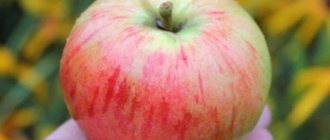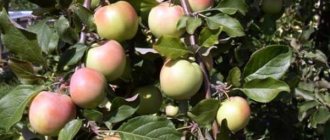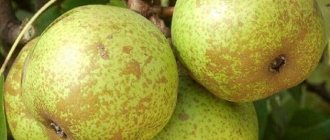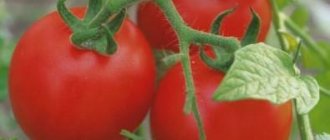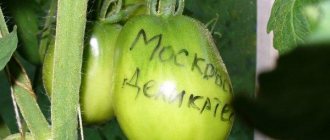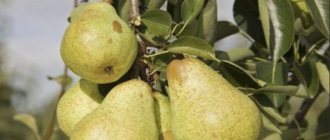The apple tree is considered a very popular fruit tree because it has very tasty and healthy fruits. Apples contain a lot of useful substances, including vitamins, acids, sugars and other elements that are necessary in the body of children and adults. In this article we will consider the Moscow winter apple tree, which is grown in the Moscow region. Since the plant has many advantages, apple trees are also grown in other regions of our country.
Description of the Moscow Winter variety
Many gardeners believe that winter apples are exclusively green.
These apples with their appearance prove the opposite.
Apple trees of this variety are very tall. Their crown is thick and round in shape. The branches are mostly located horizontally.
Young shoots are not thick, brown in color. The leaves are quite voluminous and dark green in color. The leaf blade is strongly wrinkled and highly pubescent.
The edges of the plate are heavily jagged. Inflorescences are medium size, pink.
The color of the apple is green, but as it ripens, a pink blush appears. The fruits are quite large and round in shape. The ribs are not pronounced.
The skin is medium thick, smooth to the touch. Small subcutaneous dots are visible across the entire surface of the apple.
The seeds are small, closed seed chambers. The saucer is medium size, flat. The funnel is shallow, slightly brown around the edges. The pulp is sweet and sour, dense, white.
History of selection
The Moskovskoye Zimneye apple tree variety was obtained at the Moscow State University. M.V. Lomonosov in 1963. The development of the new variety was carried out by S.I. Isaev.
Apple trees of this variety were obtained by crossing the Welsie and Antonovka vulgaris varieties. To conduct the experiment, 15 trees of the mother variety, over 10 years old, were selected.
Antonovka vulgaris acted as the father variety. During hybridization, the maternal variety, Welsey, was pollinated twice by the paternal variety. Both pollinations were successful, and the breeder was able to collect seeds of the hybrid variety.
Before further planting in the ground, the seeds were stratified from February to March. The seeds were planted in the ground under harsh conditions to give the new variety frost resistance.
The seedlings of the new variety were cared for using the mentor’s method.
Region of natural growth and features of adaptation in other regions
The region of natural growth of the Moscow winter variety is central Russia. The variety was specially bred to grow in this region, but due to its frost resistance it also adapts well to regions with colder climates.
If the variety grows in drought conditions, then abundant watering is needed for its rapid adaptation. Since apple trees absorb nutrients from the soil in dissolved form, they love loose and moist soil.
If there is a lack of moisture, the apple tree cannot accumulate the required amount of nutrients, which can lead to depletion of the apple tree.
In harsh conditions, the soils are quite poor and there are few nutrients in them. Therefore, when adapting a variety to cold conditions, it needs to be provided with regular fertilizing .
For the fastest adaptation of a young seedling, fertilizing should be done 2 times a year. In winter, the ground around the seedling should be well covered with leaves so that the roots of the young apple tree do not freeze.
Productivity
The Moscow Winter variety is a high-yielding variety . This variety will bear its first fruits 6 years after planting. The harvest volumes are quite high; when grown in favorable conditions, about 80 kilograms of apples can be harvested from one tree.
This variety bears fruit every year, but as the apple trees age, the frequency of fruiting decreases. The weight of a mature fruit is 120 grams.
Collected apples retain their characteristics for a long time. This variety is ideal for sale.
Apple tree fruiting
A two-year-old seedling can produce apples in the second or third year after planting. Gardeners recommend plucking off almost all flowers in order to direct nutrients to the development of the tree, and not to the ripening of fruits. Harvest rationing is a mandatory procedure. In addition, the plant increases resistance to diseases.
I pick the fruits at the end of October. For branches with a lot of apples, I install supports to prevent branches from breaking off. A young tree bears fruit every year, but starting from 8-9 years old, it enters the period of periodic fruiting. The harvest occurs once every two years, but this fact does not affect the popularity of the variety among summer residents.
Planting and care
In order to turn your apple tree into the center of the garden, you need to regularly care for it.
Apple trees of the Moscow winter variety are quite easy to plant. They are unpretentious to the place where they grow, but still the most suitable place for apple trees would be a well-lit one.
Apple trees should not be interspersed with other fruit trees.
It is best to plant seedlings of this variety in the autumn from late September to mid-October. For planting, you need to prepare holes 1 meter wide and no more than 60 centimeters deep.
The soil in the hole needs to be fertilized and lightly pressed down. After planting, the apple tree needs to be watered well, this will help speed up its adaptation.
Caring for an apple tree is not very difficult, but its main feature is that it must be comprehensive. By skipping even one element of care, you immediately put your apple tree in danger.
The main consequences of improper care include the occurrence of various diseases and pest invasions.
Proper care should include the following measures::
- In spring: tree inspection; removal of damaged branches, treatment of wounds.
- In summer: regular watering, pest control, loosening and cleaning the soil around the tree.
- In autumn: whitewashing the trunk, applying fertilizers.
Sweet varieties
Some may find sweet-fruited apple varieties a little bland due to the lack of bright sourness. They are worth planting for those with a “sweet tooth”, as well as for people with high acidity of gastric juice.
Kovalenkovskoe
The harvest ripens over time in the third ten days of August. The weight of the fruits is 145-215 g. They are raspberry-burgundy, round with a slight narrowing at the top. The juicy pulp exudes a delicate aroma. Medium-sized, winter-hardy trees do not suffer from scab. The variety comes from Belarus; since 2006 it has been zoned in the Moscow region.
INTERESTING! After a short storage, the apples become more tasty.
Delight
Breeders from the Moscow region bred this apple tree more than half a century ago; It was included in the Register of Breeding Achievements in 1996. Early autumn, with low susceptibility to scab. The first flowering occurs at the age of 5-6 years. Every year, elegant red fruits are produced that weigh 115-175 g. The small but dense crown requires periodic thinning, otherwise the fruits become smaller. Winter hardiness is good.
INTERESTING! The flesh of Uslada is tender, with reddish veins and the aroma of raspberries. It contains a high content of vitamins.
Belarusian sweet
This apple tree has been on the State Register of Russia since 2006. The harvest is harvested in the fall and stored until the New Year holidays. The size of the apples is 130-210 g. The skin is covered with a blurred dark crimson blush. The pulp is juicy, slightly aromatic (4.6 points). Medium-sized, drooping trees freeze a little in cold winters. An important advantage of the variety is genetic immunity to scab.
Pests and diseases
Apple trees of the Moscow winter variety practically do not get sick . They are slightly susceptible to scab. Due to improper care, diseases such as:
- Cytosporosis . The fight against cytosporosis must be comprehensive. Before the buds swell, the apple tree should be sprayed with Hom, and before flowering with a solution of copper sulfate.
- Bacterial burn . The first aid to a tree with a bacterial burn is to destroy the lesion. Affected branches must be removed and the apple tree itself disinfected.
- Black cancer . When fighting black cancer, damaged branches must be trimmed and damaged bark must be removed. The resulting wounds need to be healed and the tree disinfected.
Pests can destroy not only the crop, but also the apple tree itself. Basic pest control measures:
. To kill aphids, you need to spray the tree with tobacco infusion or a solution of laundry soap.
Green aphid- Apple moth . Spraying the tree with a chlorophos solution can destroy this parasite.
- Leaf roller . This insect primarily damages the leaves. Only a nitrophen solution can cope with it.
- Apple flower beetle . To preserve flowering and ovary, the apple tree must be sprayed with a solution of karbofos or chlorophos.
To summarize, we can say that Moscow winter apple trees are ideal for industrial breeding.
This variety is very often found on store shelves, as its long shelf life and marketable appearance make it very profitable for sales.
additional characteristics
Advantages and disadvantages
The Moscow winter apple tree, like any other fruit crop, has its advantages and disadvantages. The positive characteristics of the variety include:
- Frost resistance;
- High yield;
- Valuable qualities of fruits;
- Immunity to scab.
The disadvantage of the plant is the late onset of fruiting.
The Moscow winter apple tree is valuable for its fruits.
Zoning
In 2002, the variety was zoned in the Moscow region. Then, thanks to its high frost resistance and good yield, the fruit crop spread to many regions of Russia and Ukraine.
Dimensions of an adult tree
Due to the horizontal, wide skeletal branches, the apple tree has a round, spreading crown. The tree is quite vigorous, 9–10 meters in height , with a straight gray trunk. The foliage is light green, wrinkled, with pointed edges, slightly drooping towards the bottom.
Annual growth
The fruit crop is quite vigorous . The annual growth of the central conductor and branches is about 10 cm or more.
More on Tele4n.Net:
Garden
Moscow winter grows by 10 cm per year.
Periodicity in fruiting
The apple tree has a high annual yield , but with age, periodicity may occur.
Productivity
With proper care and proper pruning, the tree can produce up to 160 kg of fruit.
Tasting assessment
Apples weighing 200 - 300 grams, correctly round in shape . The fruits are green, but during storage they acquire a yellowish tint. The pulp is dense, fine-grained, juicy, sweet and sour. According to the tasting assessment it is 4.5 points.
Fruits of the Moscow winter apple tree.
Vitamin content in fruits
Apples of the Moscow Winter variety are valued not only for their taste, but also for their beneficial qualities. For 100 gr. fruits account for:
- Titratable acids – 80%;
- Ascorbic acid – 20 mg;
- Pectin substances – 8%;
- Tannins – 70 mg;
- P – active substances – 8.5%.
Apples also contain a large amount of vitamins such as A, B, C, E, PP.
Winter hardiness
The fruit crop is highly winter-hardy. In winter, at minus temperatures of 35 degrees, a tree rarely freezes.
The Moscow winter apple tree can withstand 35-degree frost.
Important! The tree does not tolerate spring frosts well.
Disease resistance
The variety has good immunity to powdery mildew and scab . But gardeners must be prepared for diseases such as fire blight and cytosporosis when growing apple trees on their site.
Moscow winter can be affected by cytosporosis.
Watch a video about fire blight:



